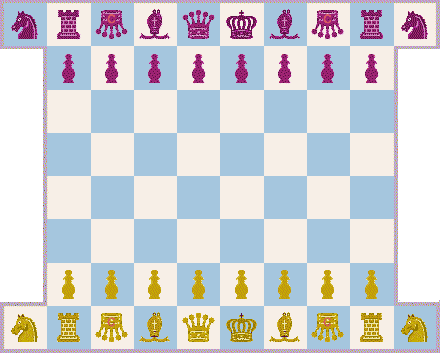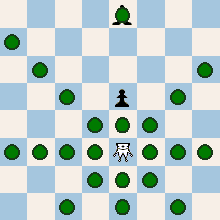

The Commodore moves like a Queen but can capture an enemy only if there is another piece (of either side) in between, and any interim squares are empty. Thus to capture it leaps over the intervening piece and lands on the enemy piece, like a cannonball. Note that the Cannon movement is also performed on the diagonals. Otherwise, rules are the same as in standard chess, except for the possibility of pawn promotion to Commodore. The Commodore's value is 5, that is, the same as a Rook.
The Commodore piece was invented in 1936 by Dr. P. Seyfert, although he gave it the name Leo (possibly it was introduced even earlier by T. R. Dawson). The board type was conceived by Gustav III of Sweden (1746-92) for his own chess variant Gustav III's Chess. The Gustavian board makes it possible to place additional pieces on the board without substantially increasing the board size. This often means that a strategical and tactical intensity is maintained. It also brings the advantage that the Knight and Bishop remain equal in value.
The Commodore is a very interesting piece for the tactician. Positionally, too, it could be quite dangerous because one can sometimes sacrifice a Commodore for a light piece (Knight or Bishop) to achieve positional ends. In the middlegame the Commodore is more valuable than a Rook, due to its dangerous tactical capabilities. But in the endgame it is less valuable than a Rook. An obvious case is the endgame King + Commodore vs. King, while it cannot give mate to the enemy King.
 The Commodore moves like a queen
but cannot capture the pawn on e5.
Instead it can capture the bishop on e8.
The Commodore moves like a queen
but cannot capture the pawn on e5.
Instead it can capture the bishop on e8.
There is also a variant where Scorpions take the place of the pawns. The Scorpion has the additional moves of a Knight, but only in two forward directions: east-north-east, and west-north-west. There are no additional capture moves. The Scorpion's value is half the value of a Knight or Bishop, that is, 1.5. This means that a light piece can be exchanged for two Scorpions, a possibility which often occurs. In the endgame it could become very dangerous, and its value often increases.
• You can download my free Commodore Chess program here (updated 2006-09-12), but you must own the software Zillions of Games to be able to run it.
• You can play Commodore Chess by e-mail, against a human opponent, here.
• Don't miss my other chess variants.
© M. Winther (August 2006).